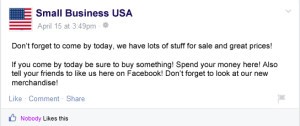— October 9, 2017

geralt / Pixabay
Just about everyone who’s been in the market for a vehicle remembers the notorious Pontiac Aztek – the “ugliest SUV ever made.” While a wide range of factors played into the series of bad decisions that led to the Aztec, it offers one crucial lesson that all marketers should take to heart. If you lose sight of the customer and allow other objectives to take priority, you will inevitably fail.
It’s much easier to say this than to put it into practice. In the case of the Aztec, the internal team actually felt the project was a huge success, by all of their internal measures. The costs were in line, it was delivered on schedule – and yet it failed, miserably.
How can we prevent ourselves, as marketers, from making these kinds of mistakes? In other words, how do we make sure the customer stays at the core of our organizational choices?
Solving customer zero’s problem
At one of my previous jobs, I was on the team driving a new service into market. The service was designed to go after a new segment adjacent to our core business – and it wasn’t too different from the product’s current set of capabilities. All the product needed was a few key features added to solve a very specific set of problems, along with new messaging and positioning. It seemed to be a great idea.
However, along the way, different teams and subcommittees kept pulling the product in all different directions – adding features no one really used, while cutting down on the core functionality. It was no surprise, then, that our sales started dropping, as did our usage metrics. Somewhere in the process, we lost our core customer segment and value. This became very clear when, at our customer advisory board meeting, a key customer stood up and said, “Why can’t your service just do x, y, z?” – naming exactly the problem the product had originally been designed to solve!
Eat your own dog food
The only way to be sure you’re creating great products and experiences is if you use those products yourself. This principle is often called “eat your own dog food,” and it’s been used to great success by companies as diverse as Coca-Cola, Apple, and YouTube. As all these companies have discovered, when everyone on the team knows they’ll have to use whatever they design, the incentive to design useful products goes through the roof.
Of course, it’s not always possible to “eat your own dog food” if your teams are designing jet turbines, for example. But even in these cases, it’s crucial to walk through the entire customer experience from their perspective.
Even if you’re just supervising marketing for a product, you’ll get much stronger results if you take pause and ask whether the marketing you’re creating would actually convert you. This degree of empathy is very difficult to maintain at the committee level – which is why it’s your job to put yourself in the place of customer zero and figure out how to delight yourself.
Unexpected use cases
No matter how focused you are on thinking like customer zero, real customers always have a way of overturning your expectations. As you move forward with various iterations of your product, you’ll often discover customers who use your product in ways you never anticipated – and if those customers account for a good percentage of sales, they’re worth listening to.
In one of my earlier roles, I was managing a product with a very small user base, which suddenly picked up a cluster of 50 new users in a small town in Minnesota. Turns out they were a group of students who were using our software to help with their homework assignments. Those kids weren’t our target audience, at all – in fact, we actually had to call and ask them what they were doing with our software, and what they wanted from it. But once we understood this, we started designing around those use cases – and those kids became some of our most loyal users.
At any sizable company, you’ll always have to coordinate teams with divergent goals. The real art of customer experience management is to align those goals around the actual needs of customer zero. This becomes much simpler when you find a way to see through customer zero’s eyes – or, better yet, to be that customer yourself.
Business & Finance Articles on Business 2 Community
(96)






